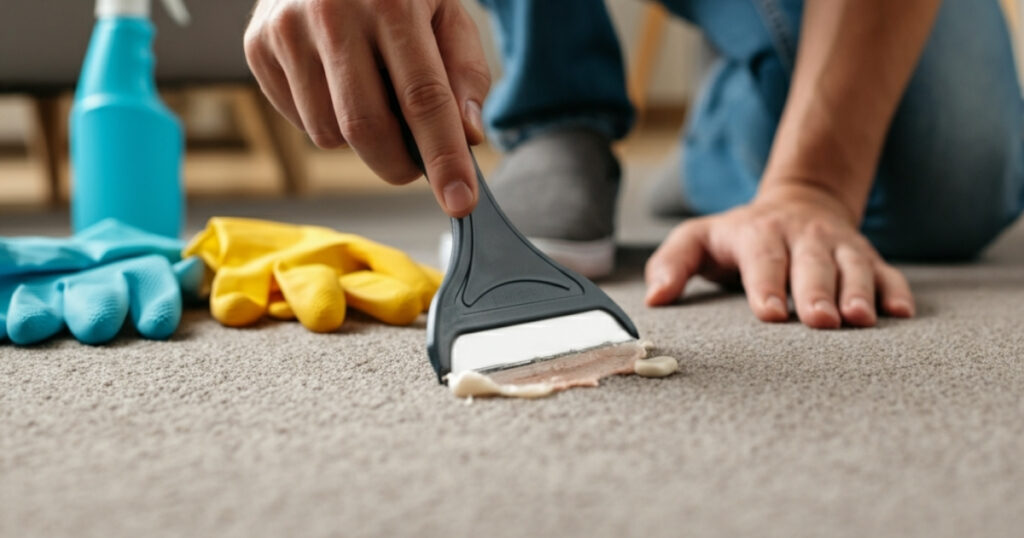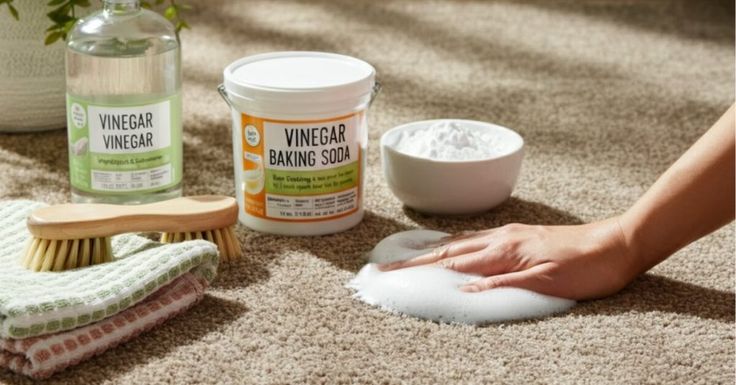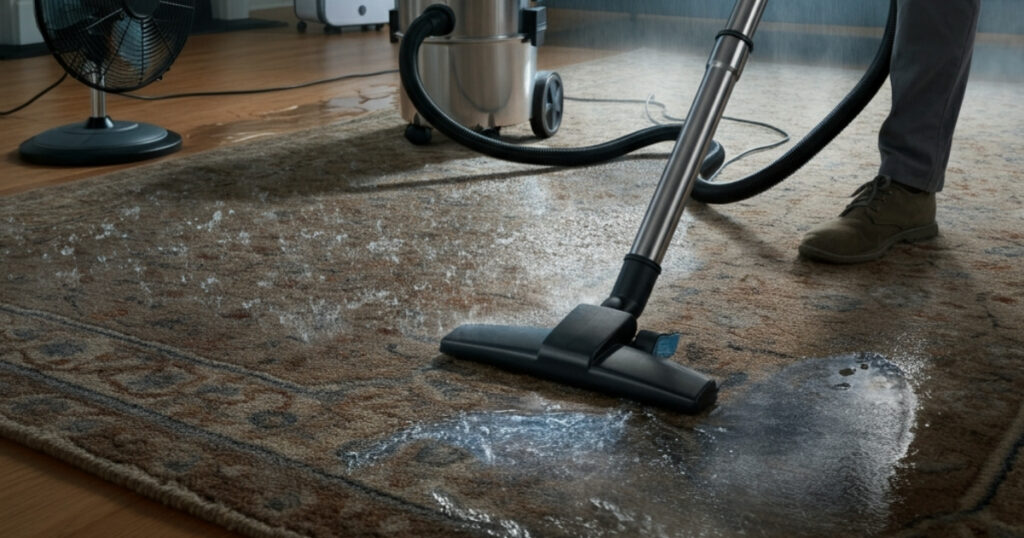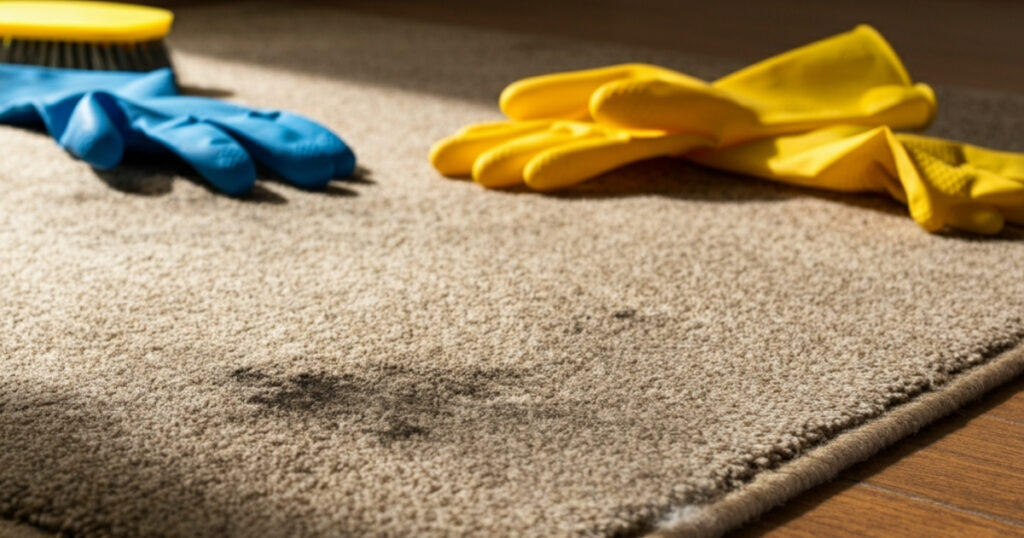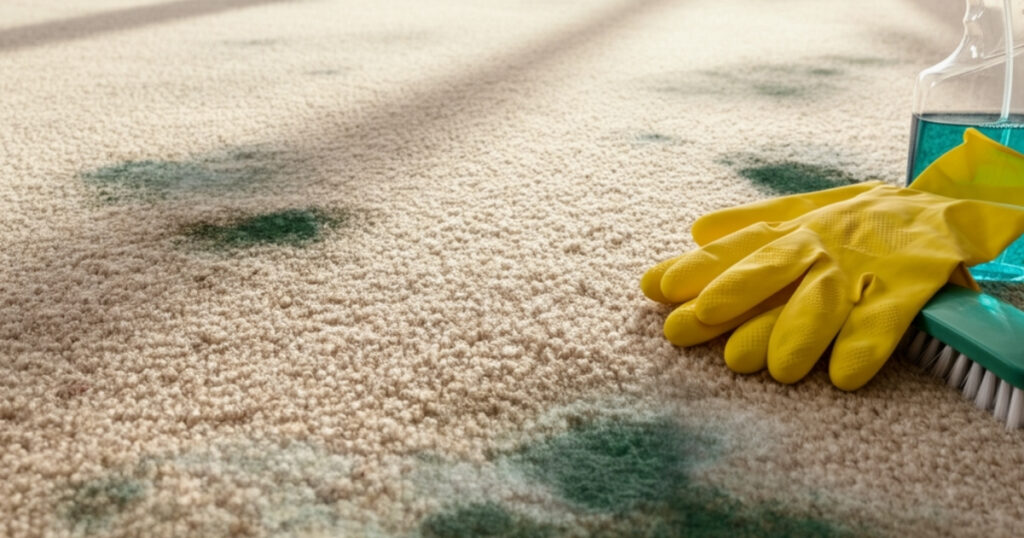As an Amazon Associate, I earn from qualifying purchases.
Getting gum stuck in your carpet can feel like a disaster, but it doesn’t have to be permanent. Whether it’s from a dropped piece of chewing gum or a sticky accident, knowing how do you get gum out of carpet effectively can save your flooring and your sanity.
The key to successful gum removal lies in understanding that heat and cold are your best friends in this situation. Additionally, having the right materials on hand makes the process much smoother. Most importantly, acting quickly prevents the gum from settling deeper into the carpet fibers, making removal significantly easier.
This comprehensive guide will walk you through multiple proven methods for removing gum from carpet, from simple ice cube techniques to household product solutions. By the end of this article, you’ll have a complete toolkit of strategies to tackle any gum situation, regardless of how long it’s been stuck or what type of carpet you’re dealing with.
Contents Overview
Understanding Why Gum Sticks to Carpet
Before diving into removal methods, it’s helpful to understand why gum becomes such a stubborn problem in carpets. Chewing gum contains polymers that become soft and pliable when warm, allowing it to conform to and grip carpet fibers tightly.
When gum lands on carpet, it quickly adapts to the texture and weaves itself between individual fibers. The longer it sits, especially in warm conditions, the more deeply embedded it becomes. This is why immediate action is always preferable.
Furthermore, carpet fibers create numerous small spaces where gum can settle and harden. Unlike smooth surfaces where gum might peel off easily, carpets present a complex landscape that requires specific techniques to navigate successfully.
Method 1: The Ice Cube Freeze Technique
The ice cube method remains one of the most popular approaches for gum removal from carpet because it’s simple and uses materials most people have at home.
Start by placing several ice cubes in a plastic bag to prevent water from soaking into your carpet. Hold the bag directly against the gum for 10-15 minutes. The cold temperature will cause the gum to harden and become brittle.
Once the gum is completely frozen, use a butter knife or spoon to gently scrape it off the carpet fibers. Work carefully to avoid damaging the carpet, scraping in one direction rather than back and forth. The frozen gum should break away in chunks.
If any residue remains, repeat the freezing process and scrape again. This method works particularly well on fresh gum that hasn’t had time to work deep into the carpet fibers.
Method 2: Using Heat to Soften Gum
While freezing hardens gum for easy removal, heat can also be effective by making the gum pliable enough to pull away from fibers. This method requires more caution to avoid damaging your carpet.
Use a hair dryer on low heat setting, holding it several inches away from the gum. Warm the gum just enough to soften it without melting it completely. Once softened, use a plastic scraper or your fingers to gently pull the gum away from the carpet.
Work quickly while the gum is warm, as it will re-harden as it cools. If the gum starts to smear instead of lifting away, stop immediately and try a different method, as spreading the gum will make the problem worse.
This technique works best on smaller pieces of gum and requires patience to get the temperature just right.
Method 3: Peanut Butter Solution
This might sound counterintuitive, but peanut butter’s oils can actually help dissolve gum’s sticky properties. The natural oils in peanut butter break down the polymers in chewing gum, making it easier to remove.
Apply a small amount of creamy peanut butter directly to the gum, working it in gently with your fingers or a soft cloth. Let it sit for about 10 minutes to allow the oils to penetrate the gum.
Once the gum has softened, use a plastic scraper to gently remove both the gum and peanut butter. You’ll need to clean the area afterward with a carpet cleaner or dish soap solution to remove any oily residue.
While this method can be effective, it does require additional cleanup steps and isn’t suitable for all carpet types, particularly light-colored carpets where oil stains might be problematic.
Method 4: White Vinegar Approach
White vinegar’s acidic properties can help break down gum while being gentle on most carpet fibers. This method is particularly useful for gum that has been stuck for a longer period.
Heat about half a cup of white vinegar in the microwave until it’s warm but not boiling. Using a clean cloth, apply the warm vinegar directly to the gum, saturating it completely.
Allow the vinegar to sit for several minutes, then use a soft brush or cloth to work at the gum gently. The acid should begin dissolving the gum’s sticky base, making it easier to scrape away.
After removing the gum, rinse the area with clean water to remove any vinegar residue, then blot dry with a clean towel. This method often requires multiple applications for stubborn gum.
Method 5: Commercial Gum Removal Products
For particularly stubborn gum or valuable carpets where you want to ensure safe removal, commercial gum removal products offer a reliable solution. These products are specifically formulated to break down gum without damaging carpet fibers.
Follow the manufacturer’s instructions carefully, as different products have varying application methods and wait times. Most require you to spray or apply the product, wait for it to penetrate the gum, then scrape or wipe away the dissolved residue.
Always test commercial products on an inconspicuous area of your carpet first to ensure they won’t cause discoloration or damage. These products tend to work faster than home remedies and often require less physical scraping.
Method 6: Dish Soap and Warm Water
A simple mixture of dish soap and warm water can be surprisingly effective for fresh gum removal. This method is gentle on carpets and safe for most fiber types.
Mix one tablespoon of liquid dish soap with two cups of warm water. Using a clean cloth, apply the solution to the gum, working from the outside edges toward the center to prevent spreading.
Let the solution sit for about 15 minutes to soften the gum, then use a plastic scraper to gently remove it. The soap helps break down the gum’s adhesive properties while lubricating the fibers for easier removal.
Rinse the area with clean water and blot dry. This method may require several applications but is one of the safest for delicate carpets.
Method 7: The Oil and Scraping Combination
Various household oils can help dissolve gum’s sticky base. Cooking oil, olive oil, or even WD-40 can be effective, though each requires different cleanup procedures.
Apply a small amount of your chosen oil directly to the gum and let it penetrate for 10-15 minutes. The oil should break down the gum’s polymers, making it less adhesive.
Use a plastic scraper to gently remove the softened gum, working carefully to avoid pushing it deeper into the carpet. Clean the area thoroughly with dish soap and water to remove any oily residue.
This method requires the most cleanup but can be very effective for old, hardened gum that other methods haven’t touched.
Post-Removal Carpet Care
After successfully removing gum from your carpet, proper cleanup ensures no residue remains that could attract dirt or cause future problems.
Start by vacuuming the area to remove any small gum pieces or debris from the removal process. Then, clean the spot with a carpet cleaner or a mild soap solution to remove any residue from your chosen removal method.
Rinse thoroughly with clean water and blot dry with clean towels. If possible, use a fan to help the area dry completely, as moisture trapped in carpet padding can lead to mold or mildew problems.
Consider applying a carpet protector spray once the area is completely dry, especially if you used oils or other products that might have compromised any existing protective treatments.
Prevention Tips for Future Gum Incidents
While knowing how to remove gum is valuable, preventing gum from getting stuck in your carpet is even better. Simple precautions can save you time and effort later.
Establish clear rules about where gum can be consumed in your home, particularly avoiding carpeted areas. Keep trash cans readily available in areas where people might be disposing of gum.
If you have children, teach them proper gum disposal techniques and consider providing small containers or tissues for gum disposal when trash cans aren’t immediately available.
Regular carpet maintenance, including frequent vacuuming and prompt attention to spills, can help you catch gum problems before they become deeply embedded.
When to Call Professional Cleaners
Some gum situations require professional intervention, particularly when dealing with expensive carpets or when DIY methods haven’t worked.
Consider professional cleaning if the gum covers a large area, if you’ve tried multiple methods without success, or if your carpet is made from delicate materials like wool or silk that could be damaged by aggressive removal techniques.
Professional cleaners have access to specialized equipment and products that aren’t available to consumers. They can also assess whether gum removal might cause more damage than leaving it alone.
Additionally, if gum removal has left stains or damaged carpet fibers, professionals may be able to repair or minimize the damage through specialized techniques.
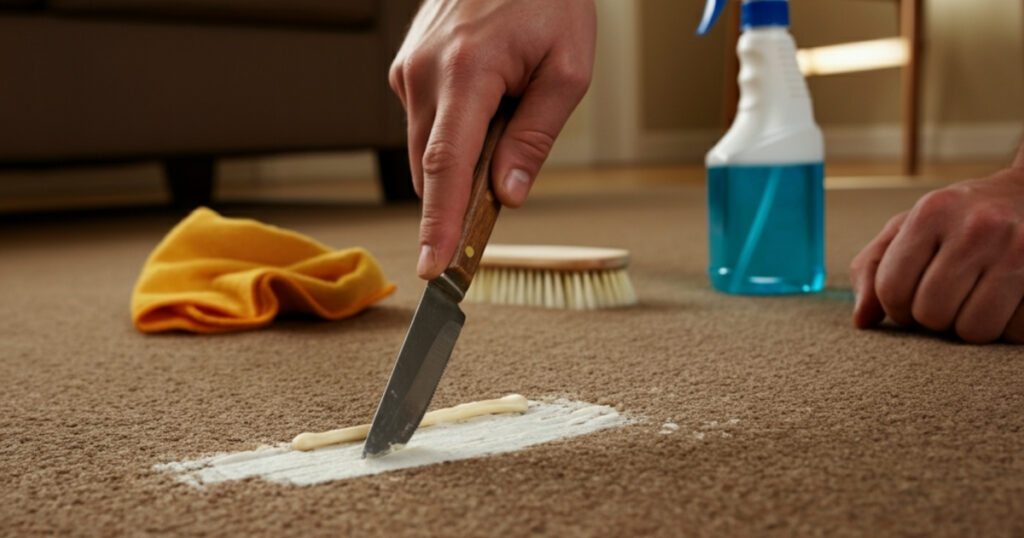
Frequently Asked Questions
1. Can you use acetone to remove gum from carpet?
Yes, acetone can dissolve gum, but it may also damage or discolor your carpet. Test in an inconspicuous area first and use sparingly with good ventilation.
2. How long does it take to freeze gum with ice cubes?
Typically 10-15 minutes is sufficient to freeze gum hard enough for removal, but thicker gum may require up to 20 minutes of continuous ice contact.
3. Will gum removal damage my carpet warranty?
Most removal methods won’t void carpet warranties, but using harsh chemicals or aggressive scraping might. Check your warranty terms and consider professional cleaning for expensive carpets.
4. Can I use a hair dryer on all carpet types?
No, synthetic carpets can melt under high heat. Always use the lowest heat setting and keep the dryer moving to prevent heat damage.
5. What if the gum has been in the carpet for months?
Old gum is more challenging but not impossible to remove. You may need to combine methods or repeat treatments several times for success.
6. Is it safe to use cooking oil on light-colored carpets?
While cooking oil can remove gum effectively, it may leave stains on light carpets. Test first and be prepared for thorough cleaning to remove oil residue.
7. How do I know if I’ve removed all the gum residue?
Run your hand over the area once it’s dry. Any stickiness indicates remaining residue that needs additional cleaning with soap and water.
8. Can I prevent gum from sticking to carpet in the first place?
Regular carpet protection treatments can make gum easier to remove, but complete prevention requires keeping gum away from carpeted areas.
Getting Your Carpet Back to Perfect Condition
Removing gum from carpet doesn’t have to be a stressful experience when you know the right techniques. Whether you choose the ice cube method for its simplicity, try household products like peanut butter or vinegar, or invest in commercial removers, success comes down to patience and proper technique.
Remember that how do you get gum out of carpet effectively depends on factors like how long the gum has been there, what type of carpet you have, and which materials you have available. Don’t be afraid to try multiple methods if your first choice doesn’t work completely.
The most important thing is to act quickly when gum gets stuck and to work gently to avoid damaging your carpet fibers. With the right approach and a little persistence, your carpet can be restored to its original condition, and you’ll have the knowledge to handle any future gum incidents with confidence.
As an Amazon Associate, I earn from qualifying purchases.

